When I first started tending to my peach tree in the backyard, I had no idea how much of a difference the right fertilizer would make. This personal journey, which you can also explore on Gobayuenergy, taught me everything from patience to the science of tree nutrition — and ultimately, how to get those juicy, delicious peaches I’d been craving. If you’re wondering which fertilizer really works for peach trees, you’re in the right place.
In this article, I’ll share my experience with three different fertilizers, the lessons I learned, and practical tips for nurturing a peach tree that actually rewards you with mouthwatering fruit. This post is tailored to gardeners and peach lovers searching for the best fertilizer to boost fruit quality. Let’s dive in!
Why Fertilizer Matters for Peach Trees
Before I got into the fertilizer tests, I learned that peach trees are hungry trees that need balanced nutrition to thrive. Their growth and fruit development depend on the right mix of nitrogen, phosphorus, and potassium (NPK), among other micronutrients.
A common problem many gardeners face is either over-fertilizing or using a product that doesn’t suit the tree’s needs, leading to poor fruit quality or even no fruit at all. Speaking from my experience, understanding what your peach tree needs seasonally makes a huge difference.
The Three Fertilizers I Tried
I tested three fertilizers over the course of one growing season. Here’s a quick overview:
1. High-Nitrogen Synthetic Fertilizer
This was the cheapest option from my local garden center. It had a high nitrogen content (24-8-8) and promised faster growth and greener leaves.
2. Organic Compost Blend
This was a homemade compost mix rich in organic matter and slow-release nutrients, including some micronutrients. It had balanced NPK values around 5-5-5.
3. Specialized Fruit Tree Fertilizer
This fertilizer was designed specifically for fruit trees, with an NPK ratio of 8-24-24, emphasizing phosphorus and potassium to improve fruit size and sweetness.
Real experiences in growing peach trees:
What Happened After a Season of Feeding?
Using High-Nitrogen Synthetic Fertilizer
What I observed: The tree grew lots of dark green leaves quickly, which was exciting at first. However, by mid-summer, there were very few flowers, and almost no fruit set. Those little peaches that did appear were small and lacked sweetness.
Lesson learned: While nitrogen is important for foliage, too much nitrogen, especially early in the season, can cause your peach tree to focus on leaves rather than flowers and fruit. This fertilizer was great for green growth but a flop for fruit production.
Using Organic Compost Blend
What I observed: The tree looked healthier overall — strong branches and robust leaves. The flowers were more abundant than with the synthetic fertilizer, and some fruit climbed onto the branches. The peaches were decent but still a little underwhelming: they were smaller and less juicy than I hoped.
Lesson learned: Organic compost improves soil health and helps with water retention and nutrient availability, but its nutrients are slower to release and less targeted. It provides a great foundation for long-term health but might not be enough alone if you want big, juicy fruit quickly.
Using Specialized Fruit Tree Fertilizer
What I observed: This was the game-changer. Once I switched to the fruit tree formula early in the blooming phase, the tree produced an abundance of flowers and plenty of fruit. Those peaches? Big, juicy, and bursting with flavor — exactly what I was hoping for.
Lesson learned: Fertilizers high in phosphorus and potassium encourage flowering and fruit development. This ratio matched what my peach tree needed perfectly. The tree looked healthy, flowered profusely, and rewarded me with juicy, delicious fruit.
Real experiences in growing peach trees:
Practical Tips for Fertilizing Your Peach Tree
If you’re inspired to try this yourself, here are some key tips I found useful:
- Test Your Soil FirstBefore dumping fertilizer, get a soil test kit or send a sample to a local extension office. Knowing nutrient levels helps you pick the right fertilizer.
- Time Your FeedingPeach trees benefit most from fertilizer in early spring, just before bud break. Avoid too much nitrogen late in the season to prevent unwanted leafy growth.
- Don’t Rely on Nitrogen AloneBalanced fertilizers with good phosphorus and potassium support flowering and fruiting. Too much nitrogen can stunt fruit growth.
- Complement Fertilizing with MulchingI found that adding a layer of organic mulch around the base conserved moisture and supported soil nutrients, boosting overall tree health.
- Water Deeply and ConsistentlyFertilizer only works if your tree is well-watered, especially in dry spells. I watered deeply every week during the growing season.
Conclusion: The Secret to Juicy Peaches
After my trial run and experience shared on Gobayuenergy, the key takeaway is clear: the right fertilizer makes all the difference. While the synthetic high-nitrogen fertilizer made my tree lush with leaves, it was the specialized fruit tree fertilizer — rich in phosphorus and potassium — that truly brought those juicy peaches to life.
Balancing organic soil health practices with targeted fertilizing and proper watering can turn your peach tree into a fruit-bearing machine. If you want more sweet, juicy peaches right in your backyard, invest in a fertilizer tailored for fruit development and feed at the right time.
I hope my journey helps you avoid the trial-and-error phase and harvest your own delicious crop soon!
Feel free to explore more gardening tips with me at Gobayuenergy — let’s make your garden thrive together!And don't forget to share my story with friends or in social media.
